The Dual of The Ironclads
February 22, 2019
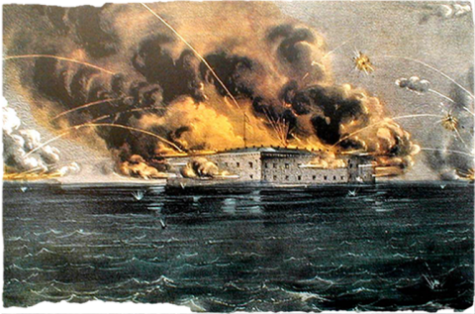
The American Civil War was a war fought in 1861 to 1865 between two regions in North America: the North and the South. During this time the United States called themselves the Union as a reference to to preserve the U.S., whereas the Confederate States called themselves the Confederacy as a reference from separating from the Union. This series of events began on April 12, 1861 near Charleston, South Carolina where the Confederacy fired on Fort Sumter, a Union military fort. At this time, South Carolina was a confederate state and didn’t want any Union property on their territory. Because of this event, it marked the beginning of a new war that changed history of our country and expanding the philosophy of democracy. However, it also influenced the creation of mass producing weapons of war and destruction. Weapons, such as guns and battleships became more powerful than the last one.
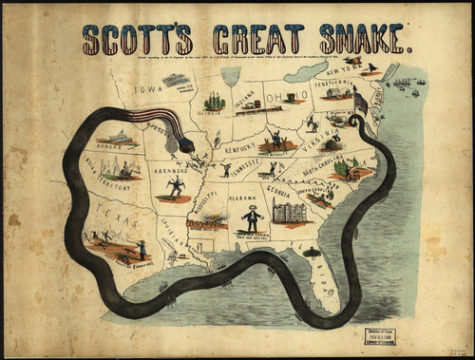
During the American Civil War, the Union had established a blockade to all Confederate ports in the southern region to prevent any trade and possible attacks to Union. With this blockade, the Union was able to hinder the Confederacy by making it difficult to deliver any goods, troops, and weapons from entering the southern states. Because of the blockade, the Union was able to mass produce weapons for themselves without having to worry about what the Confederacy was planning do in the coast. U.S. Secretary of State, William Henry Seward recommended adopting the blockade shortly after the Battle of Fort Sumter in April, 1861 which marked the beginning of the Civil War. President Abraham Lincoln sided with Seward and proclaimed the blockade on April 19. Lincoln extended the blockade to include North Carolina and Virginia on April 27. By July of 1861, the Union Navy had established blockades of all the major southern ports. The Union blockade was part of a larger strategy called the Anaconda Plan.The Union Navy used as many as 500 ships to patrol the East Coast all the way from Virginia south to Florida and the Gulf Coast from Florida to Texas. They focused their efforts on major ports and on keeping larger shipments of goods from making it through.
Results
At the start of the Civil War, many people thought that the blockade was a waste of time. They felt that the war would be over quickly and that the blockade would have little impact on the outcome of the war. However, by the end of the war, the blockade had a significant impact on the South. People across the South were suffering from a lack of supplies and the overall economy ground to a halt. This included the army, where many of the men were nearing starvation by the end of the war.
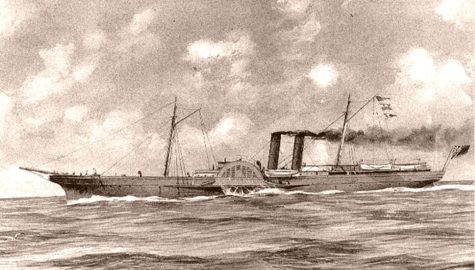
After the union finished blockading all the southern ports the Confederacy needed a way to intercept through the union blockade. In the early part of the war the Confederacy had an idea of using steam power ships, known as Blockade Runners; which were used to slightly and fast through union patrol at sea.
Interesting Facts About the Union Blockade
- The exports of cotton from the South fell by nearly 95 percent by the end of war due to the Union Blockade.
- Blockade runners could make a lot of money if their ships and cargo successfully passed the blockade.
- The Union Navy captured or destroyed around 1,500 blockade runner ships during the course of the Civil War.
- The blockade covered around 3,500 miles of coastline and 180 ports.
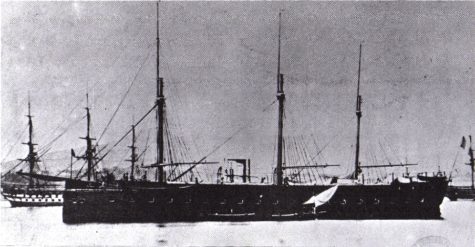
The first “ironclad” in the world was the French La Gloire. It was powered by sail and steam.
The first ironclads were built in Europe just before the Civil War, but neither North nor South possessed any of their own when the war began. Both sides began building or converting ironclads of various shapes and sizes. Some ironclads were simply normal steam ships covered with metal plates (called casemate ironclads), while the Union built a number of “Monitor” class gunboats that sat low in the water and utilized a revolving armored gun turret. Gunboats intended to sail on Western rivers typically had shallower drafts than their ocean-going counterparts, which were designed to be more stable in heavy seas. Union and Confederate ironclads first met in battle in March 1862 at the Battle of Hampton Roads – the world’s first naval engagement between ironclad warships.
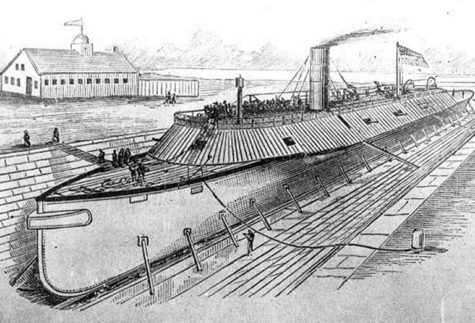
The CSS Virginia was the first ironclad built by the Confederate Navy. The CSS Manassas was built before the Virginia, but the Manassas was built by private individuals looking to use the ship as a privateer.
The Virginia’s name has caused quite a bit of confusion over the years, and is still doing so today. Originally, she was the USS Merrimack, a wooden sailing frigate also equipped with steam power. When Union forces abandoned the Norfolk Naval Yards in 1861, they burned the Merrimack to the waterline and then sank her in an attempt to keep the ship from falling into Confederate hands.
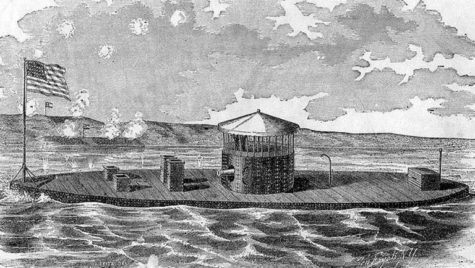
A Revolutionary Vessel
During the Civil War, the idea of the USS Monitor was born amidst a nation in turmoil. After discovering the Confederate Navy was constructing an impenetrable ironclad in Hampton Roads, Va., President Lincoln called for a naval board to propose construction of an ironclad vessel to lead the Union Navy. John Ericsson, a Swedish-American inventor, introduced a plan, which caught their attention. Complete with a rotating gun turret, low draft, sleek profile and Ericsson’s claim as an “Impregnable Battery,” the board was convinced to order swift production on what would become the USS Monitor. Construction immediately began at the Continental Ironworks in Greenpoint, Brooklyn, N.Y. Almost 100 days later, on January 30, 1862, the USS Monitor was launched into the East River.
Building The Monitor

Designed by Swedish-American engineer John Ericsson, when it was constructed, the USS Monitor represented a radical departure from traditional warship design. This Union vessel was powered by steam alone and was the first American warship with no masts and sails. With barely more than one foot of her deck visible, all machinery, storage, working, and berthing areas were below the water line.
On October 4 of 1861, Ericsson signed a contract with the Union Navy to build the Monitor for $275,000 (roughly $7.4 million in 2014), with Ericsson being liable for a full refund if the ship did not prove to be a success.
The vessel was constructed almost exclusively of iron and was heavily armored. A five-foot high, six-inch thick armor belt encircled the vessel at the water line for protection during battle. Perhaps the ship’s most novel feature was its revolving turret. Located near the middle of the ship, it was 9 feet high, 22 feet in diameter, and housed two 11-inch Dahlgren smoothbore cannon.
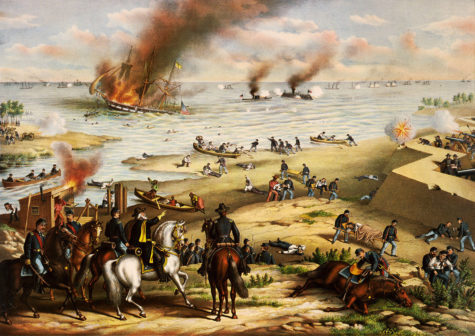
Battle of Hampton Roads
The Union’s biggest threat lived in Hampton Roads. The Confederate Navy had a stronghold on Norfolk, Va., and they had also constructed an ironclad, the CSS Virginia. On March 8, 1862, the Virginia sailed into the harbor and engaged the Union fleet inflicting major damage before retiring for the day. The next morning, CSS Virginia confidently prowled into the waters for more takings, but imagine the crew’s surprise when they saw the unfamiliar outline of the Monitor in the distance.
On March 9, 1862, the first time iron met iron, the two warships fired upon each other for hours, each side looking for their opponent’s weaknesses. Almost four hours into the battle, a shot from the Virginia exploded against the Monitor‘s pilot house and Captain Worden was temporarily blinded. The Monitor‘s Executive Officer, Samuel Dana Green, assumed command and ordered the Monitor into shallow water, where the Virginia could not follow, to assess the captain’s wounds and damage to the ship. The Virginia‘s captain, assuming the Monitor was withdrawing from battle, withdrew in supposed victory. When the Monitor returned to resume the engagement and found the Virginiagone, her crew also assumed victory.
In reality, the battle was a virtual draw with neither vessel inflicting serious damage to the other. Although the Monitor remained in Hampton Roads throughout the spring and summer of 1862, the two vessels never again met in battle. Regardless of a decisive victory never dissolving in the match between the two ironclads, one outcome was distinctly clear: the era of the wooden warship was at an end and from that day forth, iron would forever rule the seas.


